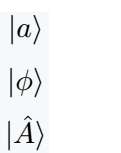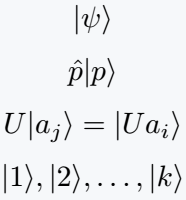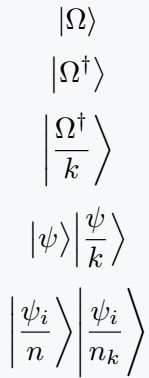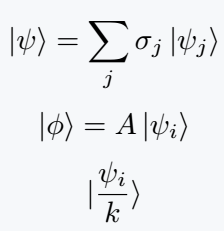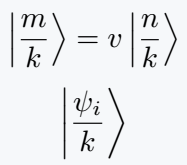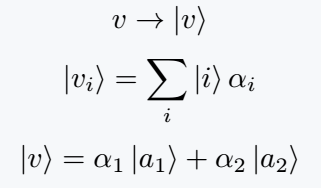Ket notation is like a kind of bracket, one side of which is bound by single bar and the other side by a right angle bracket.
\documentclass{article}
\begin{document}
\[ | a \rangle \]
\[ \vert \phi \rangle \]
\[ \vert \hat{A} \rangle \]
\end{document}Output :
Instead of typing such a large syntax, you can define a new command. Latex has multiple methods for defining new commands.
However, in this case, the best practice is to use the mathtools package.
\documentclass{article}
\usepackage{mathtools}
\DeclarePairedDelimiter\ket{\lvert}{\rangle}
\begin{document}
\[ \ket{\psi} \]
\[ \hat{p}\ket{p} \]
\[ U\ket{a_j}=\ket{Ua_i} \]
\[ \ket{1},\ket{2},\ldots,\ket{k} \]
\end{document}Output :
If you use the star * symbol with to this new command. The size of ket symbol will be adjustable with the argument.
\documentclass{article}
\usepackage{mathtools}
\DeclarePairedDelimiter\ket{\lvert}{\rangle}
\begin{document}
\[ \ket*{\Omega } \]
\[ \ket*{\Omega^\dagger} \]
\[ \ket*{\frac{\Omega^\dagger}{k}} \]
% Passing the Big Command as an optional argument
\[ \ket[\big]{\psi} \ket[\Big]{\frac{\psi}{k}} \]
\[ \ket[\bigg]{\frac{\psi_i}{n}} \ket[\Bigg]{\frac{\psi_i}{n_k}} \]
\end{document}Output :
Use braket package for ket notation
This package contains two commands \ket and \Ket. In the case of ket command, size will be fixed. For example
\documentclass{article}
\usepackage{braket}
\begin{document}
\[ \ket{\psi} = \sum_j \sigma_j\ket{\psi_j} \]
\[ \ket{\phi} = A\ket{\psi_i}\]
\[ \ket{\frac{\psi_i}{k}} \]
\end{document}Output :
And it would be best practice to use the \Ket command because the size of the notation and argument will match dynamically.
\documentclass{article}
\usepackage{braket}
\begin{document}
\[ \Ket{\frac{m}{k}} = v\Ket{\frac{n}{k}}\]
\[ \Ket{\frac{\psi_i}{k}} \]
\end{document}Output :
\Ket and \ket are considered two separate commands because of latex is case sensitive
Use physics package in LaTeX
The same command is defined in the physics package as in the bracket package. For example
\documentclass{article}
\usepackage{physics}
\begin{document}
\[ v \to \ket{v} \]
\[ \ket{v_i} = \sum_{i}\ket{i}\alpha_i \]
\[ \ket{v} = \alpha_1\ket{a_1} + \alpha_2\ket{a_2} \]
\end{document}Output :
Adding a star to the \ket command will make the shape of the notation is constant.
\documentclass{article}
\usepackage{physics}
\begin{document}
\[ \ket*{v} \]
\[ \ket*{\hat{A}_i} \]
\[ \ket*{\frac{v_i}{k}} \]
\end{document}
Output :
